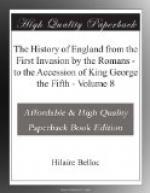We left Fleetwood on the right bank pushing the Scots slowly before him. At length they resigned the hope of resistance; their flight opened to him the way to St. John’s, and its timid commander yielded at the first summons. On the other bank, Cromwell stormed the Fort Royal, put its defenders, fifteen hundred men, to the sword, and turned the guns upon the city. Within the walls irremediable confusion prevailed, and the enemy began to pour in by the quay, the castle hill, and the Sidbury gate. Charles had not a moment to spare. Placing himself in the midst of the Scottish cavalry, he took the northern road by the gate of St. Martin’s, while a few devoted spirits, with such troopers as dared to followed them, charged down Sidbury-street in the contrary direction.[1] They accomplished their purpose. The royal party cleared the walls, while they arrested the advance, and distracted the attention of the enemy. It was past the hour of sunset; and before dark all resistance ceased. Colonel Drummond surrendered the castle hill on conditions; the infantry in the street were killed or led prisoners to the cathedral; and the city was abandoned during the obscurity of the night to the licentious passions of the victors.[2]
In this disastrous battle the slain on the part of the royalists amounted to three thousand men, the taken to a still greater number. The cavalry escaped in separate bodies; but so depressed was their courage, so bewildered were their counsels, that they successively surrendered to smaller parties of their pursuers. Many officers of distinction attempted, single and disguised,
[Footnote 1: These were the earl of Cleveland, Sir James Hamilton, Colonel Careless, and captains Hornyhold, Giffard, and Kemble.—Boscobel, 20.]
[Footnote 2: See Blount, Boscobel, 14-22; Whitelock, 507, 508; Bates, part ii. 221; Parl. Hist. xx. 40, 44-55; Ludlow, i. 314. Nothing can be more incorrect than Clarendon’s account of this battle, iii. 409. Even Cromwell owns that “it was as stiff a contest for four or five hours as ever he had seen.”—Cary’s Memorials, ii. 356.]




